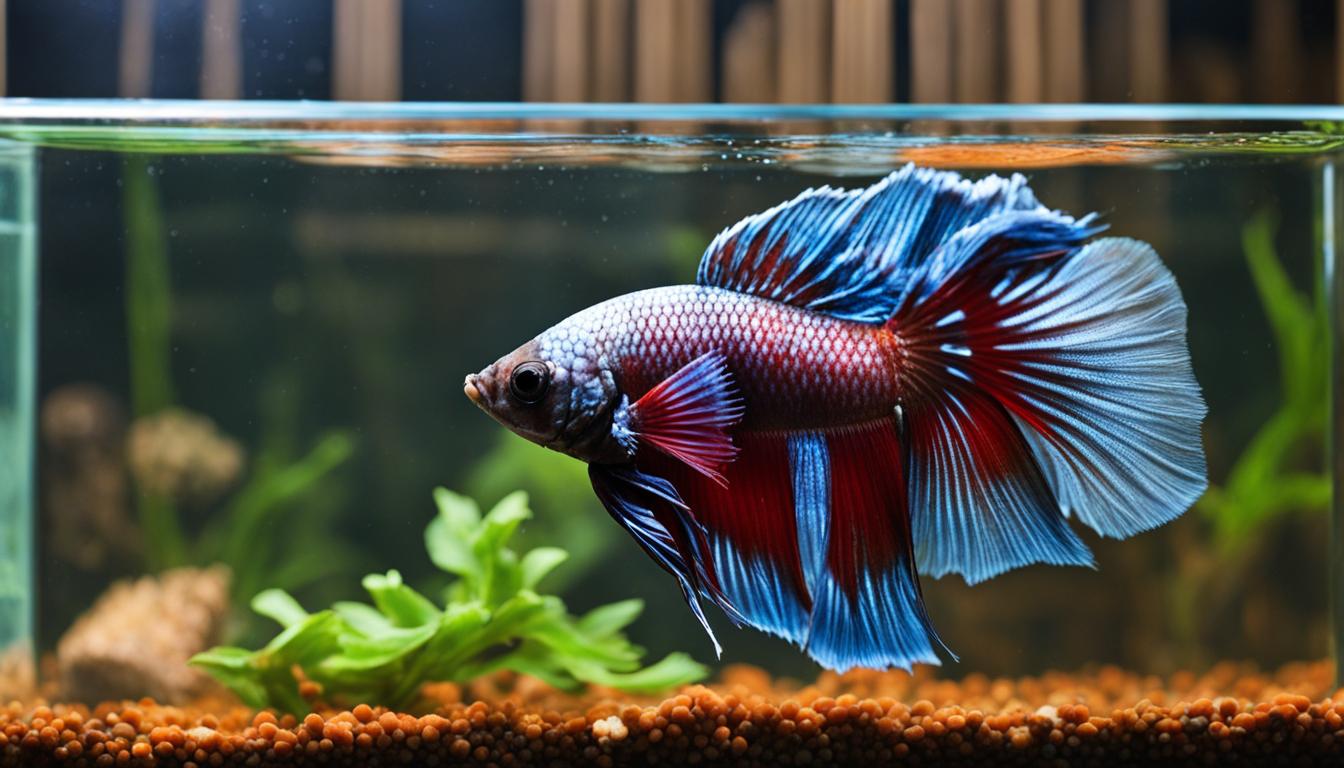Last Updated on 4 months by admin
As a betta fish owner, it’s important to be aware of velvet disease, also known as gold dust disease, and how to treat it effectively. This parasitic infection can have serious consequences for your fish if left untreated, but with the right steps, you can help your betta fish recover and thrive.
In this comprehensive guide, we’ll walk you through all the steps you need to take to successfully treat velvet in betta fish. From understanding the disease and setting up a quarantine tank, to administering medication and maintaining water quality, we’ve got you covered.
Key Takeaways:
- Velvet disease is a common parasitic infection that affects betta fish.
- Quarantining the infected betta fish is crucial to prevent the spread of velvet disease to other fish.
- Increasing the water temperature can aid in the treatment of velvet in betta fish.
- Administering medication with active ingredients such as malachite green or copper sulfate is key to treating velvet disease in betta fish.
- Regular water changes and maintaining optimal water quality are essential during the treatment process.
Understanding Velvet Disease in Betta Fish
Before delving into the treatment options, it’s crucial to fully comprehend what velvet disease is and how it affects betta fish. Velvet disease, also known as gold dust disease, is a parasitic infection caused by a protozoan called Oodinium. It appears as a fine, velvet-like coating on the fish’s body and fins. This parasite can cause severe harm to your betta fish, including lethargy, loss of appetite, rapid breathing, and a dull appearance. Recognizing these symptoms early on can help prevent the disease from spreading further.
To treat velvet in betta fish, it’s essential to quarantine the infected fish and set up a separate tank with clean water. Optimal water conditions are crucial, and you should maintain stable water parameters throughout the entire treatment process.
The Appearance of Velvet Disease in Betta Fish
One of the primary characteristics of velvet disease is the velvet-like coating, which can appear yellow, green, or grayish in color, on the body and fins of the fish. This parasite can also cause respiratory distress, affecting the gills and causing rapid breathing. Infected fish may also display a lack of appetite and uncharacteristic lethargy. To diagnose velvet disease in betta fish, it’s crucial to observe these symptoms closely.
| Common Symptoms of Velvet Disease in Betta Fish | |
|---|---|
| Velvet-like coating | 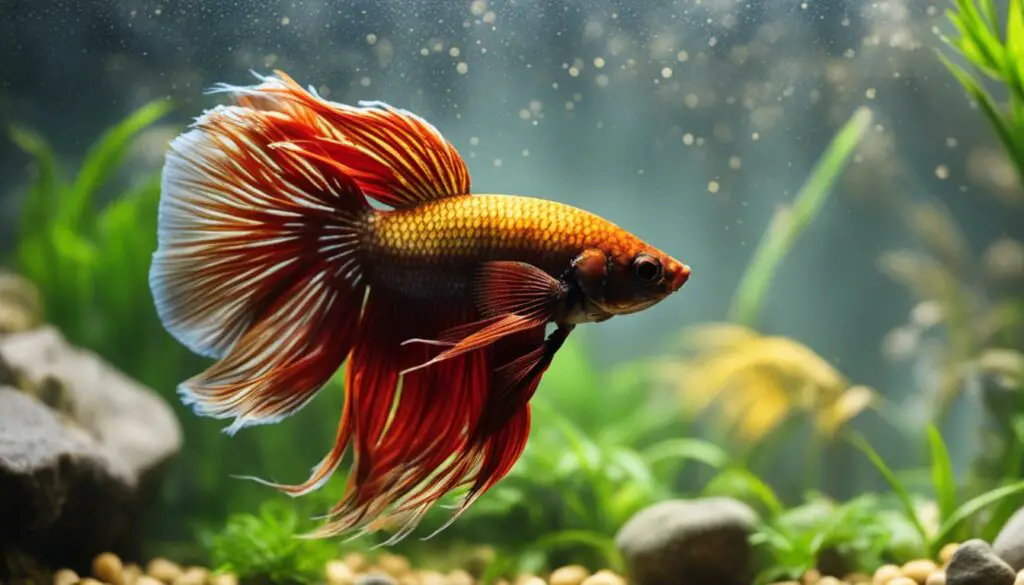
|
| Lethargy |  |
| Rapid breathing |  |
| Loss of appetite |  |
| Dull appearance |  |
While these symptoms may not necessarily indicate the presence of velvet disease, if you observe any of them, it’s wise to quarantine and closely monitor your betta fish.
Quarantine the Infected Betta Fish
If you suspect your betta fish has velvet disease, the first step is to quarantine the fish to prevent the spread of the infection to other fish. Set up a separate tank with clean water and maintain optimal water conditions. Remember to transfer your betta fish gently to avoid any unnecessary stress. This will help reduce the risk of secondary infections and provide a controlled environment for treatment.
To create an ideal quarantine tank, ensure that the water temperature is between 80-82°F (27-28°C), and the pH level is around 7.0-7.2. You can also add an air stone or a slow filter to provide adequate aeration and maintain water flow.

During the quarantine period, it’s also essential to monitor the fish’s behavior and overall health. Look out for any signs of distress, lethargy, or loss of appetite, which may indicate that the fish is not responding well to treatment. The quarantine period typically lasts for 2-3 weeks, depending on the severity of the infection.
Increase Water Temperature
The best treatment for velvet in betta fish is to increase the water temperature in the tank. As Oodinium thrives in cooler water, heating the tank can help inhibit the growth of the parasite. However, it’s important to ensure that the temperature increase is gradual and monitored closely. A sudden temperature shock can be harmful to the fish.
Please note that not all fish can tolerate high temperatures, so be sure to research the specific needs of your betta fish before increasing the temperature. If you have other fish in the tank, make sure they can also tolerate the higher temperature.
Here is a table outlining the ideal water temperature for betta fish:
| Betta Fish Type | Ideal Water Temperature |
|---|---|
| Siamese Fighting Fish (Betta splendens) | 75-82°F (24-28°C) |
| Wild Betta Fish | 75-80°F (24-27°C) |
If you are unsure about how to heat the tank, there are several options available. A submersible heater can be placed in the tank to maintain the desired temperature. Alternatively, you can use a heating pad or lamp, but make sure to position them safely and monitor the temperature regularly.
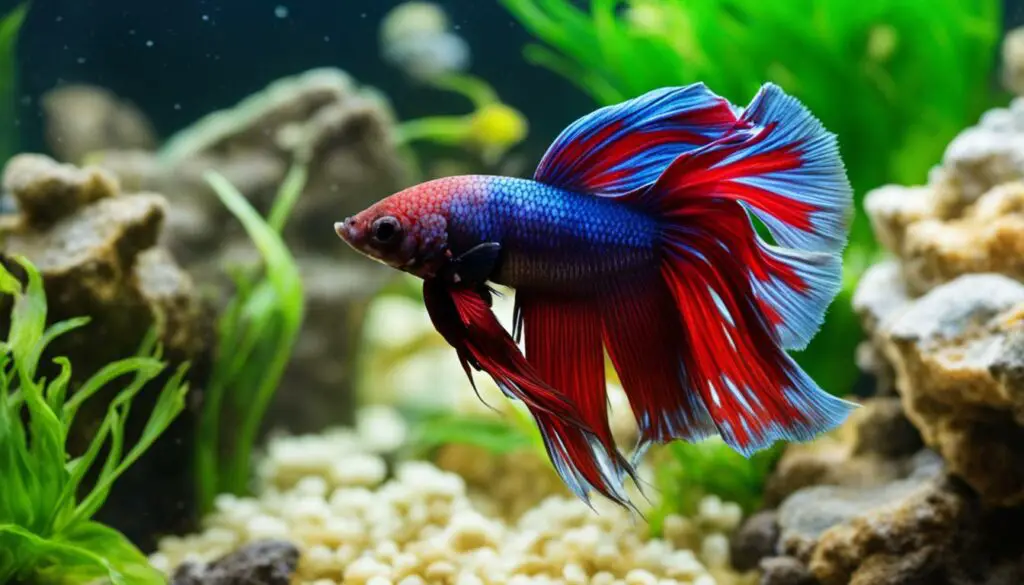
Remember to keep a close eye on the water temperature and adjust if necessary. By increasing the temperature and combining it with other treatment options, you can effectively combat velvet disease in betta fish and help your fish make a full recovery.
Administer Medication
There are several medications available that can effectively cure velvet in betta fish. Look for products that contain active ingredients such as malachite green or copper sulfate. These medications are available in liquid, powder, or tablet form, and can be easily administered into the tank.
Before administering the medication, it’s important to read and follow the instructions provided by the manufacturer. Overdosing can harm your betta fish, so be sure to measure the medication carefully, and use the recommended dosage amount. Additionally, ensure that any carbon filters are removed from the tank during the medication period, as they can absorb the medication and reduce its effectiveness.
Note: It’s important to only use medication that is specifically designed for betta fish and velvet disease treatment. Do not use medication intended for other fish species, as they may contain different active ingredients that could harm your betta fish.
Administering medication can cause stress to your betta fish, which may further weaken their immune system. To minimize stress, ensure the medication is evenly dispersed throughout the tank and monitor your betta fish’s behavior and symptoms closely during the treatment period.
| Active Ingredient | Product Name |
|---|---|
| Copper Sulfate | Copper Sulfate Pentahydrate Crystals |
| Malachite Green | Seachem Cupramine |
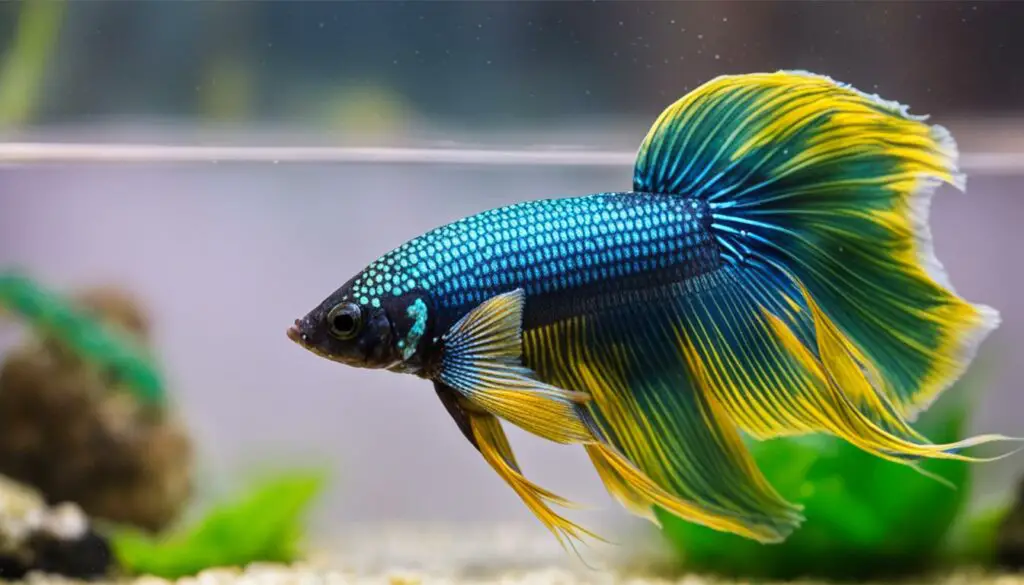
Perform Regular Water Changes
Regular water changes are crucial for maintaining good water quality and removing excess parasites during the treatment process for velvet in betta fish. Follow these tips to perform effective water changes:
- Use a gravel siphon to remove debris from the bottom of the tank.
- Remove 25-30% of the water in the tank every few days and replace it with clean, conditioned water.
- If the water quality is poor, increase the frequency of water changes to every other day or daily.
Remember to monitor the water temperature and pH level to prevent any sudden changes that could harm the fish. Additionally, make sure to properly condition the water before adding it to the tank to avoid any negative effects from chlorine or other chemicals.
Example Water Change Schedule for a 10-Gallon Tank
| Day | Action |
|---|---|
| Day 1 | 25-30% water change |
| Day 3 | 25-30% water change |
| Day 5 | 25-30% water change |
| Day 8 | 25-30% water change |
| Day 11 | 25-30% water change |
| Day 15 | 25-30% water change |
By performing regular water changes, you can help your betta fish recover from velvet disease and maintain their overall health and well-being.

Dim the Lighting
One of the lesser-known velvet in betta fish treatment options is dimming the lighting in the tank. Velvet parasites are sensitive to light, so reducing the intensity and duration of light exposure can help combat the infection and aid in the healing process. To dim the lighting, you can cover the tank or use a dimmer.
Did you know? Dimming the lighting in the tank can also assist in minimizing stress on the infected fish, which is especially crucial during the treatment process.
Remember to monitor the water temperature, perform regular water changes, administer medication, provide a nutritious diet, and utilize natural remedies (if appropriate) to maximize the effectiveness of velvet in betta fish treatment options. With patience and persistence, your betta fish can fully recover from velvet disease and regain their health and vitality.
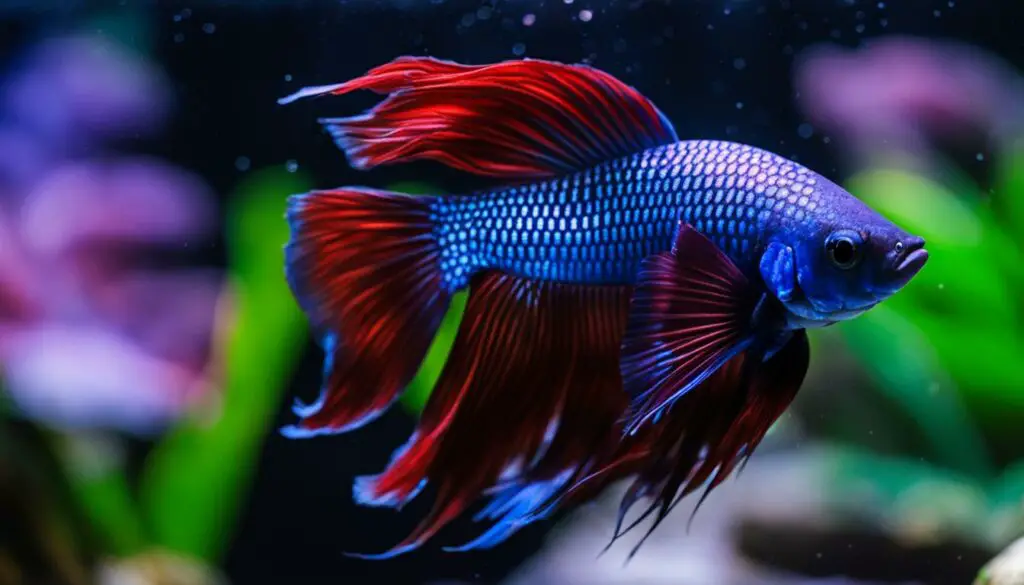
Provide a Nutritious Diet
A well-balanced diet is essential for betta fish to maintain good health and aid in their recovery from velvet disease. Offer high-quality betta fish food that is rich in protein and essential nutrients, such as brine shrimp or bloodworms. Supplementing their diet with frozen or live foods can provide a boost to their immune system. (SEO: betta fish health tips for treating velvet)
It’s important to avoid over-feeding betta fish, as this can lead to water quality issues. Only give them the amount of food they can consume in a few minutes, once or twice a day. (SEO: betta fish health tips for treating velvet)
| Do: | Don’t: |
|---|---|
|
|

“A well-balanced diet is essential for betta fish to recover from velvet disease and maintain good health.”
Utilize Natural Remedies
Along with conventional medication, natural remedies can complement the treatment of velvet in betta fish. These remedies are often used in conjunction with medications to help alleviate symptoms and boost the fish’s immune system. It’s important to note that natural remedies should be used under the guidance of an aquatic veterinarian or expert. Here are some natural remedies that may help in the treatment of velvet in betta fish:
Adding Aquarium Salt
Aquarium salt can help to reduce stress and improve the gills’ function in betta fish. It can also help reduce the number of parasites present on the fish’s body and fins. When using aquarium salt, it’s essential to use the correct amount and concentration to avoid any adverse effects on the fish’s health. It’s important to note that aquarium salt should not be used as a substitute for medication.
Indian Almond Leaves
Indian almond leaves have antifungal and antibacterial properties and can help reduce stress in betta fish. They also contain tannins, which can help improve water quality and reduce the growth of parasites. Adding Indian almond leaves to the tank can help promote healing and reduce the risk of any secondary infections.
Herbs
Several herbs are known for their antiparasitic properties and can be used to help in the treatment of velvet in betta fish. These include garlic, cumin, and turmeric, among others. These herbs can be added to the fish’s diet in small amounts or used to make a tea that can be added to the tank. However, it’s important to consult with an aquatic veterinarian or expert before using any herbs.
Image

Monitor and Maintain Water Quality
Betta fish are known for their sensitivity to poor water conditions, which can exacerbate the symptoms of velvet disease. Therefore, it’s crucial to monitor and maintain optimal water quality throughout the treatment process.
Regular testing of water parameters such as temperature, pH, ammonia, nitrite, and nitrate levels is essential. Keep the water clean by performing partial water changes of around 25-30% every few days, ensuring the new water is properly conditioned before adding it to the tank.
Additionally, make sure to remove any uneaten food or debris from the tank as this can contribute to poor water quality. A high-quality filter can also help maintain good water conditions and reduce the risk of velvet disease in the future.
Example of Water Quality Parameters for Betta Fish
| Parameter | Ideal Range |
|---|---|
| Temperature | 78-82°F (25.5-28°C) |
| pH | 6.5-7.5 |
| Ammonia | 0 ppm |
| Nitrite | 0 ppm |
| Nitrate | 20 ppm or below |
Tip: Regular water changes not only help maintain good water quality but also reduce the stress on betta fish, which is critical for their overall health and recovery.

“The key to treating velvet in betta fish is to maintain excellent water conditions, so regular testing and maintenance are essential. Remember to perform partial water changes every few days, keep the water clean, and utilize a high-quality filter.”
Conclusion
Monitoring and maintaining optimal water quality is crucial when treating velvet disease in betta fish. By performing regular water tests, keeping the water clean, and utilizing a high-quality filter, you can ensure that your betta fish has the best chance of recovering from this condition.
Patience and Persistence
Treating velvet disease in betta fish requires consistent effort and patience. While it’s important to follow the steps outlined in this guide, it’s equally important to remain persistent and committed to the treatment process.
It may take several weeks for the fish to fully recover from velvet disease, and it’s crucial to continue the treatment even after the visible symptoms disappear. Discontinuing the treatment prematurely can lead to a relapse, prolonging the recovery process.
Additionally, it’s important to monitor the betta fish’s behavior and health closely throughout the treatment process. Look out for any signs of distress or relapse and take the necessary action promptly.
Overall, treating velvet disease in betta fish requires a combination of effort, patience, and persistence. By following the steps outlined in this guide and remaining committed to the treatment process, you can help your betta fish recover from velvet disease and ensure their continued health and well-being.

Expert Tip:
“Remember to maintain a clean and stable aquarium environment throughout the treatment process. A clean tank with optimal water parameters can help support your betta fish’s immune system and aid in their recovery.” – Dr. John, Aquatic Veterinarian
Conclusion
Now you have a comprehensive understanding of how to treat velvet in betta fish. Remember to quarantine the infected fish, increase water temperature, administer appropriate medication, perform regular water changes, and provide a nutritious diet. Additionally, monitoring water quality and utilizing natural remedies can contribute to the overall success of the treatment. With patience and persistence, you can help your betta fish recover from velvet disease and ensure their continued health and well-being.
So, if you notice any signs of velvet disease in your betta fish, don’t panic! Follow the steps outlined in this guide and provide the necessary treatment to help your fish recover. Remember that treating velvet in betta fish requires patience and persistence but it is worth it when you see your betta fish happy and healthy again. By taking care of your betta fish, you can ensure a long and happy life for your beloved pet.
FAQ
What is velvet disease in betta fish?
Velvet disease, also known as gold dust disease, is a parasitic infection caused by the protozoan Oodinium. It appears as a fine velvet-like coating on the fish’s body and fins.
What are the symptoms of velvet disease?
Symptoms of velvet disease in betta fish include lethargy, loss of appetite, rapid breathing, and a dull appearance.
How do I quarantine an infected betta fish?
Set up a separate tank with clean water and maintain optimal water conditions to prevent the spread of velvet disease to other fish.
Should I increase the water temperature to treat velvet in betta fish?
Yes, raising the water temperature to around 82-86°F (28-30°C) can aid in the treatment of velvet as Oodinium thrives in cooler water.
What medications should I use to treat velvet disease?
Look for medications containing active ingredients like malachite green or copper sulfate. Follow the instructions provided by the manufacturer for proper administration.
How often should I perform water changes during the treatment process?
Aim for partial water changes of around 25-30% every few days to remove excess parasites and maintain good water quality.
Should I dim the lighting in the tank during treatment?
Yes, dimming the lighting can help reduce the parasite’s ability to thrive. You can cover the tank or use a dimmer to reduce the intensity and duration of light exposure.
What should I feed my betta fish during the treatment process?
Offer a well-balanced and nutritious diet that is rich in protein and essential nutrients. Supplement their diet with frozen or live foods like brine shrimp or daphnia for an immune system boost.
Are there any natural remedies for treating velvet in betta fish?
Along with conventional medication, you can try adding aquarium salt, Indian almond leaves, or certain herbs known for their antiparasitic properties. Consult with an aquatic veterinarian or expert before using any home remedies.
How important is it to monitor and maintain water quality?
It is crucial to regularly test water parameters and keep the water clean and stable. This supports the betta fish’s immune system and aids in their recovery.
How long does it take for betta fish to recover from velvet disease?
Treating velvet disease requires patience and persistence. It may take several weeks for the fish to fully recover, so it’s important to continue the treatment even if visible signs of velvet are no longer present.

